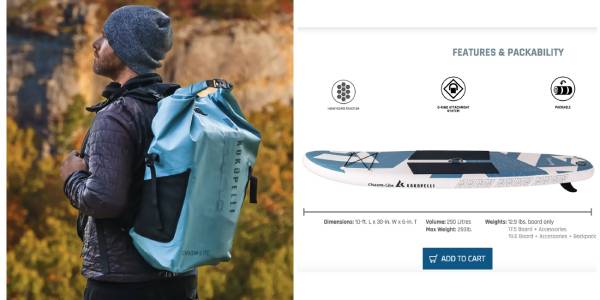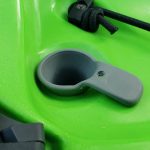No single method is applicable for fastening a kayak in place. It is beneficial to be ready, since people might be very creative. You are expecting that it won’t be worth the effort to secure your kayak and that they’ll go further away.
Take into account that if a robber is set on grabbing your boat, they will work out how to pilfer it.
Ensure that you have a top-notch and cost-effective kayak lock in your kayaking gear bag; these are available in numerous styles. Write down your boat’s identification number.
Doing this will be beneficial if your kayak is ever taken without permission. Creating a deterrent that is both difficult and hazardous to thieves is the key to securing a kayak.
How To Lock Your Kayak
The options you have for locking your kayak are contingent upon the type and where it needs to be secured.
Anchor Point Locking Sit-On-Top Kayaks
Attaching a sit-on-top kayak to an anchor point is an often-used way of securing it. Possibilities for outside storage include a massive tree, a rack specifically designed to hold kayaks, or a stake firmly inserted into the ground.
The problem is that your point of reference must be firm and unchanging. Someone looking to steal a kayak would be able to tell if they are yours, making it possible for them to take them away.
Sit-on-top kayaks have holes for a cable to go through for easy locking after you have found a place to park. Getting a kayak lock for sit-on-top kayaks is pretty cheap because of that. You can solve your problem by buying a piece of wire and a keyed or combination lock from a nearby hardware store.
If you are wanting to secure numerous kayaks at the same time, you will usually need to formulate a strategy. Most hardware stores can aid you in getting a section of cable that is straight, then help you shape and secure it into loops on either end.
You must thread a length of rope through the sleeves, tie it in a loop, and thread it back to the other end of the sleeve before compressing it.
To rig your kayak with a rope sleeve, you should make sure that the loops are small enough to fit through the scupper holes present in a sit-inside kayak. Prior to utilizing the item, you should apply duct or Gorilla tape to the periphery of the rope sleeve and the terminal point of the wire passing through it.
The ends of this cable may become frayed over time and can sometimes cause the stainless steel strands to become separated. It is possible that the edges could become hazardous if they are left exposed.
So it is important to cover them with something like tape that can act as a guard and protect your skin from getting hurt. You have to loop the cable around the anchor point, then run one loop into the other loop, and secure it firmly.
Thread the exterior line through the scupper holes, and then bring it over the top of the kayaks until it reaches the anchor point. Secure it there by looping it back to the other end of the line.
If you don’t have enough length, you can also connect the internal loop directly to the cord which goes straight between the two kayaks.
Anchor Point Locking Sit Inside Kayaks
Sit-inside kayaks are more tricky to secure than others due to the fact that they don’t have the holes that would enable you to thread a cable through them. This group utilized a large, downed tree trunk as a major support point.
The cable was passed around the tree once and connected to the front and back of each kayak.
Attach one side of the rope to the front of the sit-inside kayak and the other end to the back of the vessel if you are just tying it up to a landmark. It would be impossible for a potential thief to undo the cable loop attached to the bow or stern of the kayak, as there is not enough give in the line.
If you want an easy way to secure a sit-inside kayak to a secure place, it might be better to buy a specifically-made kayak lock instead of trying to make your own. A lock that can be opened with either one key or a combination, as well as two cables, are needed for this strategy.
Sit-On-Top Kayaks Locked Together
You could connect multiple sit-on-top kayaks if you have them, in order to make them harder to take while you’re not around. It is much harder for a single criminal to get away with stealing multiple kayaks.
That is the main idea behind this approach. If they are firmly tied up and can’t be easily taken apart, this is even more accurate.
By employing the same basic strategy aspreviously discussed, you can securesit-on-top kayaks to a mooring. Pass the cable through the openings in the kayak, then draw it back to connect the two ends.
You might be able to use enough of the wire to thread it through two outlets before tying off the ends. Without a secure anchor point to attach the kayak to, this tactic will become a further deterrent for potential kayak robbers.
Sitting Inside Kayaks Are Locked Together
If no anchor point is functional nearby, connecting sit-in kayaks to one another is a great way to assure safety. The issue with sit-in kayaks is that they don’t have any openings through which a cord may be strung.
Many sit-in kayaks have metal loops attached to the deck in the front and back which are similar in appearance to the image above. These loops can be utilized to attach two sit-inside kayaks together, but a much narrower rope will be necessary than what is required to attach them to an anchoring point.
This means you will have to attach your line to the points of stability on your sit-in boats.
You will have to ascertain the size of the area below those circles to guarantee that your lock will be able to pass through the hole. If your kayak has rails, you may install tie-down eyelets to give yourself extra possibilities for securing the kayaks together. Here’s an illustration of how these eyelets appear:
These openings are designed to fit into the edges of your kayak and give extra spots to which attach a cable lock. You have a choice of ways to secure sit-in kayaks when the attachment points are too far away to link them together.
Locking Up At Home
It is advisable to keep your kayak in a secure place, such as a shed, garage, or house, with the door locked when not in use. This could mean that it is not visible to any likely robbers. However, it is not always possible to do this.
If possible, make sure to keep your kayak as near to your residence when storing it outside. You may consider installing a wall rack on the outside of your house, which can help keep your boat upright and away from the ground.
To secure it, you would need to find something solid to attach a cord to. An eyebolt screwed into the wall could be a possible solution. You could also construct your own backyard wooden shelf which would provide you a safer place to link a lock wire through.
You may want to think about putting a tarp or cover over your yak if it is stored outdoors so that it stays shielded from the weather.
Locking When On The Road
When you’re bringing your kayak with you on a trip, it could mean that you’re having to set it down in unfamiliar places. To make sure your kayak is properly secure when heading out on a camping or overnight trip, it is wise to lock it up.
A cable lock can be very useful for tying your kayak to a roof rack so that it can’t be stolen. Sit-on-tops usually include scupper holes which can be used to feed the cord through so that it can then be fastened to a rooftop carrier.
If you are using a kayak with a built-in seating area, you might need to drill a hole into it. You may want to take into consideration the best spot on your kayak to make sure that it stays watertight. If you have a storage shelf or cup holder inside your cockpit, making a hole here may be a good idea so long as it does not penetrate the hull.
You can use the same procedure to attach it to a truck or trailer, taking advantage of the tie down points located inside the truck bed or trailer.
Camping
When you go camping, it’s possible that you may not have access to your car, so attaching your boat to it might not be possible. You do not want to experience the disappointment of discovering your vehicle is missing when you wake up.
Equally, you can utilize the same techniques you would utilize to attach your vessel to the rooftop shelf, by employing a cable lock. Instead of having a roof rack, you should look for a lasting structure close to your campgrounds.
You could use any lasting fixture in your vicinity, whether it be a tree, pier, or something else, as a spot to camp near. Secure the tent near your camping area instead of by the body of water.
What Else Can I Do To Prevent My Kayak Or Canoe From Being Stolen?
Keep It Out Of Sight
Thieves who take advantage of chances may think of snatching your kayak if it is left alone. Hence, it is essential to not offer them any chances. If they see that your cargo is secured, they may not attempt to seize it as it would take too long and they could be caught in the act.
The best course of action is to store your boat out of sight and in a garage or shed, however if this is not an option use a tarp to cover it up so that others can’t identify it.
Always Lock It Up
It’s important to secure your yak when you’re not around, regardless of your destination. Even if you plan to go to an isolated spot for a meal outdoors. If you tie your bike to a tree, a dock, or a post, you can be sure it will stay put even after you take a break to eat.
It is wise to secure your yak when hauling it on the top of your car, in the bed of your pickup, or in your trailer. Even if you’re just stopping for gas. Ensure you lock it tightly before departing on your trip; it will spare you time while you are traveling.
Get It Insured
Getting insurance for your kayak can provide you with peace of mind if you have expended considerable funds on buying it.
It might be a good idea to find out if your home insurance includes cover for kayaks and canoes before you buy separate insurance for them.
What To Look Out For When Buying A Lock For Your Kayak
Key Or Combination Lock
It is essential to think about the locking system when selecting a lock for your kayak. This will often be down to personal preference. A vital part of having a key lock is to make sure that you always have the key on your person.
Using a combination lock eliminates the need to be concerned about misplacing a key. It can be beneficial to write down your combination number and store it in a secure place, such as on your mobile device, to use as a reference if you happen to misplace it.
Length
You should pay attention to the size of the lock as it must be big enough to be able to secure your kayak. The length of many locking cables and straps is given, rather than the dimensions of the boat they will fit.
Take into consideration how deep your kayak is when crafting the straps to go around it – don’t just use double the width of the kayak. This may be a larger difficulty if you possess an extensive fishing kayak.
Verify that the diameter of the cable you are using is the same size as the scupper holes on your vessel.
Corrosion Resistance
The ability to resist corrosion should be taken into account when you are deciding on a spot to store your kayak outdoors. This will safeguard the fastening system and stop your kayak from corroding metal wires.
Most locking cables usually come with a covering that prevents rust from building up on them. The coating can also be useful in avoiding your vessel or vehicle being scratched. Some locks will also be coated, which can help maintain good functionality and prove advantageous in marine areas.




